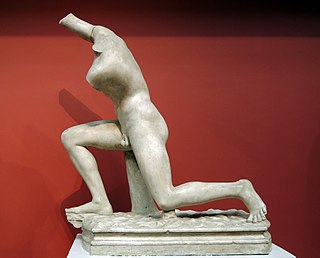
In Greek mythology, Silenus was a companion and tutor to the wine god Dionysus. He is typically older than the satyrs of the Dionysian retinue (thiasos), and sometimes considerably older, in which case he may be referred to as a Papposilenus. The plural sileni refers to the mythological figure as a type that is sometimes thought to be differentiated from a satyr by having the attributes of a horse rather than a goat, though usage of the two words is not consistent enough to permit a sharp distinction. Silenus presides over other daimons and is related to musical creativity, prophetic ecstasy, drunken joy, drunken dances and gestures.

Praxiteles of Athens, the son of Cephisodotus the Elder, was the most renowned of the Attica sculptors of the 4th century BC. He was the first to sculpt the nude female form in a life-size statue. While no indubitably attributable sculpture by Praxiteles is extant, numerous copies of his works have survived; several authors, including Pliny the Elder, wrote of his works; and coins engraved with silhouettes of his various famous statuary types from the period still exist.

The Capitoline Museums are a group of art and archaeological museums in Piazza del Campidoglio, on top of the Capitoline Hill in Rome, Italy. The historic seats of the museums are Palazzo dei Conservatori and Palazzo Nuovo, facing on the central trapezoidal piazza in a plan conceived by Michelangelo in 1536 and executed over a period of more than 400 years.

The study of Roman sculpture is complicated by its relation to Greek sculpture. Many examples of even the most famous Greek sculptures, such as the Apollo Belvedere and Barberini Faun, are known only from Roman Imperial or Hellenistic "copies". At one time, this imitation was taken by art historians as indicating a narrowness of the Roman artistic imagination, but, in the late 20th century, Roman art began to be reevaluated on its own terms: some impressions of the nature of Greek sculpture may in fact be based on Roman artistry.

The Borghese Vase is a monumental bell-shaped krater sculpted in Athens from Pentelic marble in the second half of the 1st century BC as a garden ornament for the Roman market; it is now in the Louvre Museum.

Mensun Bound is a British maritime archaeologist born in Stanley, Falkland Islands. He is best known as director of exploration for two expeditions to the Weddell Sea which led to the rediscovery of the Endurance, in which Sir Ernest Shackleton and a crew of 27 men sailed for the Antarctic on the 1914–1917 Imperial Trans-Antarctic Expedition. The ship sank after being crushed by the ice on 21 November 1915. It was rediscovered by the Endurance22 expedition on 5 March 2022.

The Antikythera Ephebe, registered as: Bronze statue of a youth in the museum collections, is a bronze statue of a young man of languorous grace that was found in 1900 by sponge-divers in the area of the ancient Antikythera shipwreck off the island of Antikythera, Greece. It was the first of the series of Greek bronze sculptures that the Aegean and Mediterranean yielded up in the twentieth century which have fundamentally altered the modern view of ancient Greek sculpture. The wreck site, which is dated about 70–60 BC, also yielded the Antikythera mechanism, a characterful head of a Stoic philosopher, and a hoard of coins. The coins included a disproportionate quantity of Pergamene cistophoric tetradrachms and Ephesian coins, leading scholars to surmise that it had begun its journey on the Ionian coast, perhaps at Ephesus; none of its recovered cargo has been identified as from mainland Greece.

The Marathon Boy or Ephebe of Marathon is a Greek bronze sculpture found in the Aegean Sea in the bay of Marathon in 1925.

Pliny the Elder records five bronze statues of Amazons in the Artemision of Ephesus. He explains the existence of such a quantity of sculptures on the same theme in the same place by describing a 5th-century BC competition between the artists Polyclitus, Phidias, Kresilas, "Kydon" and Phradmon; thus:
The most celebrated of these artists, though born at different epochs, have joined in a trial of skill in the Amazons which they have respectively made. When these statues were dedicated in the Temple of Diana at Ephesus, it was agreed, in order to ascertain which was the best, that it should be left to the judgment of the artists themselves who were then present: upon which, it was evident that that was the best, which all the artists agreed in considering as the next best to his own. Accordingly, the first rank was assigned to Polycletus, the second to Phidias, the third to Cresilas, the fourth to Cydon, and the fifth to Phradmon.

The Hermes Ludovisi, also formerly known as Mercurio Oratore, is a Hellenistic sculpture of the god Hermes in his form of Hermes Psychopompus. It is made of Italic marble and is a somewhat slick 1st-century AD Roman copy after an inferred bronze original of the 5th century BC which is traditionally attributed to the young Phidias, ca 440 BC, or alternatively called "Myronic". Its model is among the earliest sculptural representations of Hermes as beardless and youthful. It was acquired by Cardinal Ludovico Ludovisi for the Ludovisi collection and is now on show at the Palazzo Altemps.

The Furietti Centaurs are a pair of Hellenistic or Roman grey-black marble sculptures of centaurs based on Hellenistic models. One is a mature, bearded centaur, with a pained expression, and the other is a young smiling centaur with his arm raised. The amorini are missing that once rode the backs of these centaurs, which are the outstanding examples of a group of sculptures varying the motif.

The Archaeological Museum of Chania is a museum that was located in the former Venetian Monastery of Saint Francis at Chalidon Street, Chania, Crete, Greece. It was established in 1962. In 2020 this location closed and Chania's new archaeological museum relocated to 15 Skra Str. Chalepa, in 2022.
The Kizilburun shipwreck is an ancient Roman shipwreck in the Aegean that was discovered in 1993 by Dr. Cemal Pulak. The wreck itself is located just off the western coast of Turkey, near the island of Chios and the city of Çeçme. The coordinates of the wreck are 38.26075°N 26.24256°E. The ship itself was a Navis Lapidera, or Roman stone carrying ship. The wreck was found at a depth of 45–48 meters or around 150 feet.

The Resting Satyr or Leaning Satyr, also known as the Satyr anapauomenos is a statue type generally attributed to the ancient Greek sculptor Praxiteles. Some 115 examples of the type are known, of which the best known is in the Capitoline Museums.

The Head of a Philosopher is a fragment of a bronze sculpture of Magna Graecia, discovered in 1969 on a shipwreck in the Straits of Messina. It is now in the Museo Nazionale della Magna Grecia in Reggio Calabria, Italy.

The Subiaco Ephebe is a sculpture of a young man approaching puberty found on the site of the Neronian Villa Sublaquensis at Subiaco in the upper Aniene valley, Lazio, Italy. The headless marble is a copy of a lost Greek bronze, as evidenced by an awkward tree-trunk support and "the failure of the total silhouette to keep manageably within the boundaries of a single block of stone", as Rhys Carpenter observes; it is unlikely to postdate Nero because of its find location. The date of the bronze original that it reflects is contested. When it was first found August Kalkmann gave it a date early in the fifth century BCE. but general opinion before World War II made it a work of the end of the fourth century in the turn towards Hellenistic style, to which Rhys Carpenter objected, suggesting instead that it belonged in the 60s or 70s of the fifth century. Brunilde Sismondo Ridgway, in a radical redating of the history of Greek sculpture, has placed it among classicising works of the first century BCE.

The Sleeping Ariadne, housed in the Vatican Museums in Vatican City, is a Roman Hadrianic copy of a Hellenistic sculpture of the Pergamene school of the 2nd century BC, and is one of the most renowned sculptures of Antiquity. The reclining figure in a chiton bound under her breasts half lies, half sits, her extended legs crossed at the calves, her head pillowed on her left arm, her right thrown over her head. Other Roman copies of this model exist: one, the "Wilton House Ariadne", is substantially unrestored, while another, the "Medici Ariadne" found in Rome, has been "seriously reworked in modern times", according to Brunilde Sismondo Ridgway. Two surviving statuettes attest to a Roman trade in reductions of this familiar figure. A variant Sleeping Ariadne is in the Prado Museum, Madrid. A later Roman variant found in the Villa Borghese gardens, Rome, is at the Louvre Museum.
The Mahdia Museum is a museum in Tunisia specialising in Tunisian archaeology and heritage. It is located in the city of Mahdia.

Konya Archaeological Museum is a state archaeological museum in Konya, Turkey. Established in 1901, it had been relocated twice before moving to its present location in 1962. One of the most prominent displays in the museum is of sarcophagi and other antiquities from the ancient city of Çatalhöyük. Other exhibits relate to the Neolithic, Bronze Age, Iron Age, Classical, Hellenistic, Roman and the Byzantine periods; artifacts consist of ceramic ware, stone and bronze wares, ornaments and inscriptions. Among the objects displayed is a marble sarcophagus of the 3rd century AD, with elaborate relief sculptures depicting the life of Hercules. In the outer open yard of the museum there are a number of small sculptures, sarcophagi, column capitals, and samples of epigraphy.

















